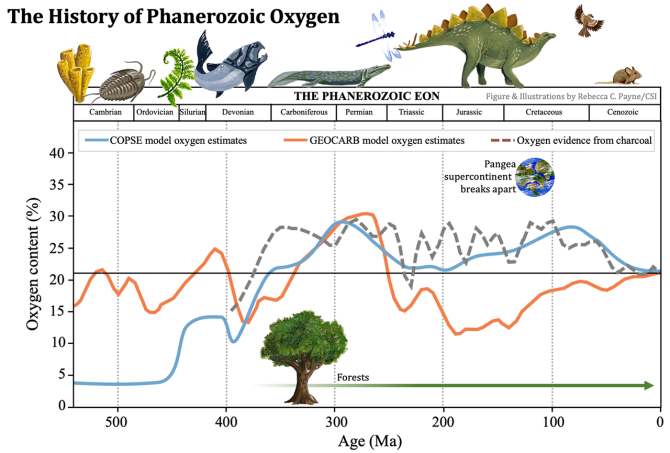Jurassic worlds might be easier to spot than modern Earth
By James Dean, Cornell Chronicle
Might a tyrannosaur roam on Trappist-1e, a protoceratops on Proxima Centauri b, or a quetzalcoatlus on Kepler 1047c?
Things may not have ended well for dinosaurs on Earth, but Cornell astronomers say the “light fingerprint” of the conditions that enabled them to emerge here – including abundant atmospheric oxygen – provides a crucial missing piece in our search for signs of life on planets orbiting other stars.
Their analysis of the most recent 540 million years of Earth’s evolution, known as the Phanerozoic Eon, finds that telescopes could better detect potential chemical signatures of life in the atmosphere of an Earth-like exoplanet more closely resembling the age the dinosaurs inhabited than the one we know today.
Two key biosignature pairs – oxygen and methane, and ozone and methane – appeared stronger in models of Earth roughly 100 million to 300 million years ago, when oxygen levels were significantly higher. The models simulated the transmission spectra, or light fingerprint, generated by an atmosphere that absorbs some colors of starlight and lets others filter through, information scientists use to determine the atmosphere’s composition.
“Modern Earth’s light fingerprint has been our template for identifying potentially habitable planets, but there was a time when this fingerprint was even more pronounced – better at showing signs of life,” said Lisa Kaltenegger, director of the Carl Sagan Institute (CSI) and associate professor of astronomy in the College of Arts and Sciences (A&S). “This gives us hope that it might be just a little bit easier to find signs of life – even large, complex life – elsewhere in the cosmos.”
Kaltenegger is co-author of “Oxygen Bounty for Earth-like Exoplanets: Spectra of Earth Through the Phanerozoic,” published Nov. 2 in Monthly Notices of the Royal Astronomical Society: Letters. The first author, Rebecca Payne, research associate at CSI and in the Department of Astronomy (A&S), led the new models that detail a critical epoch including the origins of land plants, animals and dinosaurs. Over that period, atmospheric oxygen ranged from below 10% to as high as 35% before stabilizing at the contemporary level of 21%.
Using estimates from two established climate models (called GEOCARB and COPSE), the researchers simulated Earth’s atmospheric composition and resulting transmission spectra over five 100-million-year increments of the Phanerozoic. Each features significant changes as a complex biosphere diversified, forests proliferated and terrestrial biospheres flourished, influencing the mix of oxygen and other gasses in the atmosphere.
“The Phanerozoic is just the most recent 12% or so of Earth’s history, but it encompasses nearly all of the time in which life was more complex than microbes and sponges,” said Payne, an astrobiologist and geologist. “These light fingerprints are what you’d search for elsewhere, if you were looking for something more advanced than a single-celled organism.”
For most of the past 400 million years, oxygen is believed to have ranged within the charcoal “fire window” of 16% to 35%: Any less and fires couldn’t ignite, any more and they couldn’t be extinguished. Its estimated peak around 30%, some 300 million years ago, is thought to have made possible the emergence of large, complex creatures like dinosaurs, which lived from roughly 245 million to 66 million years ago.
While similar evolutionary processes may or may not unfold on exoplanets, Payne and Kaltenegger said their models fill in the missing puzzle piece of what a Phanerozoic Earth would look like to a telescope, creating new templates for habitable planets with varying atmospheric oxygen levels.
Kaltenegger pioneered modeling of what Earth would look like to faraway observers based on changes over time in its geology, climate and atmosphere – our “ground truth,” she said, for identifying potential evidence of life on other worlds.
To date, about 40 rocky exoplanets have already been discovered in habitable zones where oceans could exist, Kaltenegger said. Analyzing an exoplanet’s atmosphere – if it has one – is at the edge of technical capability for NASA’s James Webb Space Telescope, but is now a possibility. However, the researchers said, scientists need to know what to look for. Their models identify planets like Phanerozoic Earth as extremely promising targets for finding life in the cosmos.
They also allow scientists to entertain the possibility – purely theoretical – that if a habitable exoplanet is discovered to have an atmosphere with 30% oxygen, life there might not be limited to microbes, but could include creatures as large and varied as the megalosauruses or microraptors that once roamed Earth.
“If they’re out there,” Payne said, “this analysis lets us figure out where they could be living.”
Dinosaurs or not, the models confirm that from a great distance, such a planet’s light fingerprint would stand out more than a modern Earth’s.
“Hopefully we’ll find some planets that happen to have more oxygen than Earth right now, because that will make the search for life just a little bit easier,” Kaltenegger said. “And who knows, maybe there are other dinosaurs waiting to be found.”
The authors thanked the Carl Sagan Institute and the Brinson Foundation for supporting the research.
Media Contact
Get Cornell news delivered right to your inbox.
Subscribe

